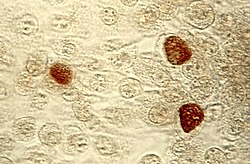| Chlamydiota | |
|---|---|

| |
| Chlamydia trachomatis | |
| Scientific classification | |
| Domain: | Bacteria |
| Kingdom: | Pseudomonadati |
| Superphylum: | PVC |
| Phylum: | Chlamydiota Garrity & Holt 2021[3] |
| Class: | Chlamydiia Horn 2016[1][2] |
| Orders and families | |
| Synonyms | |
| |
The Chlamydiota (synonym Chlamydiae) are a bacterial phylum and class whose members are remarkably diverse, including pathogens of humans and animals, symbionts of ubiquitous protozoa,[4] and marine sediment forms not yet well understood.[5] All of the Chlamydiota that humans have known about for many decades are obligate intracellular bacteria; in 2020 many additional Chlamydiota were discovered in ocean-floor environments, and it is not yet known whether they all have hosts.[5]
Of various Chlamydiota that cause human disease, the two most important species are Chlamydia pneumoniae, which causes a type of pneumonia, and Chlamydia trachomatis, which causes chlamydia. Chlamydia is the most common bacterial sexually transmitted infection in the United States, and 2.86 million chlamydia infections are reported annually.
- ^ Horn M. (2010). "Class I. Chlamydiia class. nov.". In Krieg NR, Staley JT, Brown DR, Hedlund BP, Paster BJ, Ward NL, Ludwig W, Whitman WB (eds.). Bergey's Manual of Systematic Bacteriology. Vol. 4 (2nd ed.). New York, NY: Springer. p. 844. doi:10.1007/978-0-387-68572-4. ISBN 978-0-387-95042-6.
- ^ Oren A, Garrity GM (2016). "Validation list no. 170. List of new names and new combinations previously effectively, but not validly, published". Int J Syst Evol Microbiol. 66 (7): 2463–2466. doi:10.1099/ijsem.0.001149. PMID 27530111.
- ^ Oren A, Garrity GM (2021). "Valid publication of the names of forty-two phyla of prokaryotes". Int J Syst Evol Microbiol. 71 (10): 5056. doi:10.1099/ijsem.0.005056. PMID 34694987. S2CID 239887308.
- ^ Sixt BS, Siegl A, Müller C, Watzka M, Wultsch A, Tziotis D, et al. (2013). "Metabolic features of Protochlamydia amoebophila elementary bodies—a link between activity and infectivity in Chlamydiae". PLOS Pathogens. 9 (8): e1003553. doi:10.1371/journal.ppat.1003553. PMC 3738481. PMID 23950718.
- ^ a b Dharamshi JE, Tamarit D, Eme L, Stairs CW, Martijn J, Homa F, et al. (March 2020). "Marine Sediments Illuminate Chlamydiae Diversity and Evolution". Current Biology. 30 (6): 1032–1048.e7. Bibcode:2020CBio...30E1032D. doi:10.1016/j.cub.2020.02.016. PMID 32142706. S2CID 212423997.
© MMXXIII Rich X Search. We shall prevail. All rights reserved. Rich X Search
